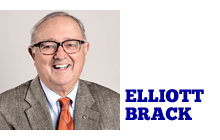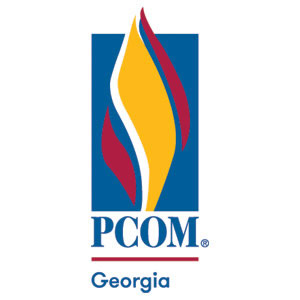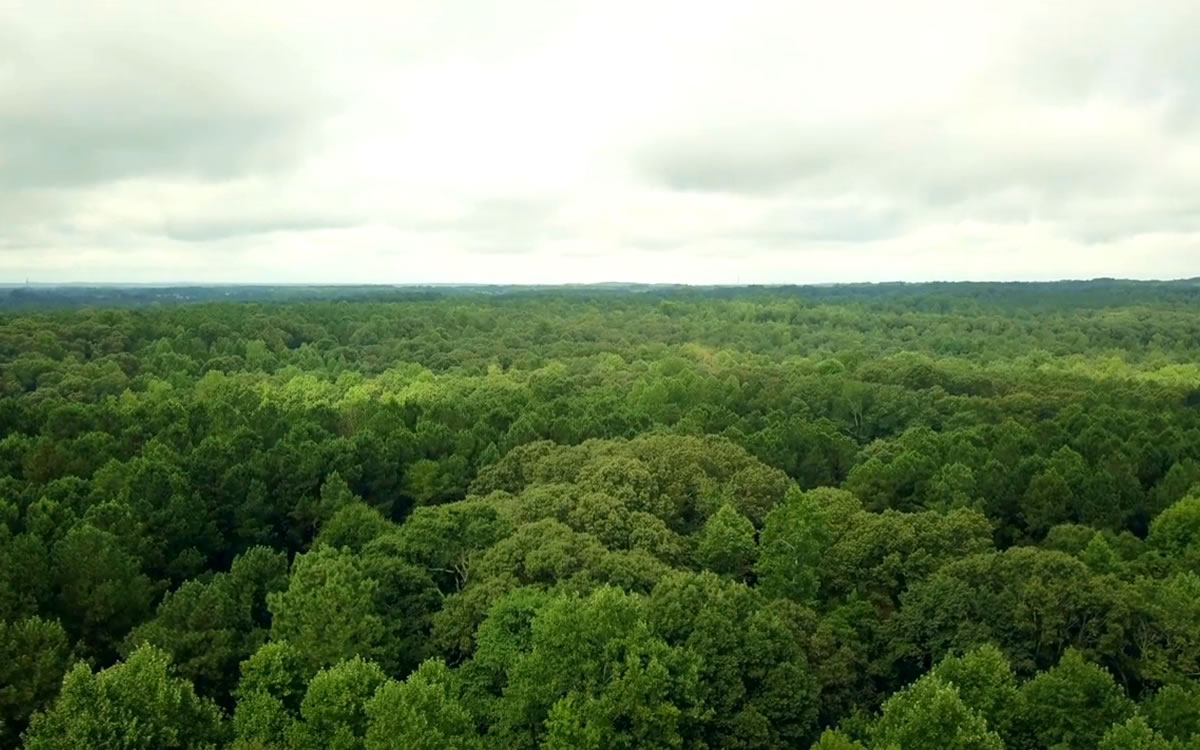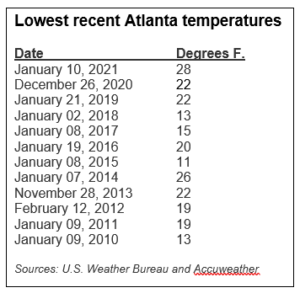GwinnettForum | Number 21.17 | March 2, 2021
NEW DEVELOPMENTS in the Rowen project in Gwinnett came this week, when a community advisory board was announced. For more on what is anticipated to be a gigantic land project, see Today’s Focus below.
 TODAY’S FOCUS: Rowen Foundation taps 18 people for Community Advisory Task Force
TODAY’S FOCUS: Rowen Foundation taps 18 people for Community Advisory Task Force
EEB PERSPECTIVE: Extremes in local weather; Why your mail arrived later
ANOTHER VIEW: Reviewing China, the British Empire, opium and saving face
SPOTLIGHT: Gateway85 Gwinnett
FEEDBACK: Living near a time zone border can be very embarrassing
UPCOMING: PCOM Georgia readies students for vaccination effort
NOTABLE: Gateway85 CID adopts Freight Transit Study west of I-85
RECOMMENDED: Driving Mr. Albert by Michael Paterniti
GEORGIA TIDBIT: English native was designer of the Gwinnett County Courthouse
MYSTERY PHOTO: Here’s what we think is a “cream puff” Mystery Photo
CALENDAR: Pathquest coming to Braselton on March 13
Rowen Foundation taps 18 people for Community Advisory Task Force
By Brian Brodrick
LAWRENCEVILLE, Ga. | The Rowen Foundation has tapped 18 Gwinnett leaders to serve on its Gwinnett Community Advisory Task Force. The task force is charged with identifying opportunities for Rowen to support, strengthen, and partner with surrounding public, private, and civic stakeholders, and is composed of leaders in business, education, health, faith and community service.
 The Advisory Task Force will work with Rowen Foundation staff, governing board and others to ensure that broad community input is secured as the 2,000-acre knowledge community moves deeper into its planning phases.
The Advisory Task Force will work with Rowen Foundation staff, governing board and others to ensure that broad community input is secured as the 2,000-acre knowledge community moves deeper into its planning phases.
Mason Ailstock, president of the Rowen Foundation, will serve as the convener of the group. He says: “A critical priority for the Rowen Foundation is ensuring deep and meaningful community engagement and input as we begin to get more specific in our planning. This group of advisors will provide invaluable guidance as we begin the hard work in earnest.”
Task force members include:
- Nicole Love Hendrickson, chairwoman, Gwinnett Board of Commissioners;
- Jasper Watkins, Gwinnett County District 3, commissioner;
- Chuck Efstration, Georgia House District 104;
- The Rev. Marlon Allen, Ramp Marketing LLC;
- Major Michelle Anglin, Gwinnett County Police Department;
- Dr. Valerie Cadet, PCOM Georgia;
- Everton Blair, Jr., chairman of the Gwinnett County Board of Education;
- Frederick Dawkins, attorney;
- Melvin Everson, Gwinnett Technical College; Ashish Gandhi, OFS Fiber Optics;
- Santiago Marquez, Latin American Association;
- Doug Jenkins, chairman, Gwinnett Chamber of Commerce;
- Beverly Paff, president, Gwinnett Historical Society;
- Jessica Stewart, Gwinnett County Government; and
- Dr. Tyler Yu, dean of School of Business, Georgia Gwinnett College.
Sachin Shailendra, chairman of the board of directors of Rowen Foundation, says: “Rowen offers the elements needed to generate unprecedented economic, educational and innovative impacts rooted in the history of the site and the state. But these elements are nothing without the leadership, creativity, rigor, and partnerships to put them to work. All aspects of Rowen’s development must be actively and equitably shaped, and we are excited to welcome the Task Force to help guide our approach to actualizing these benefits.”
Announced in August, Rowen is a knowledge community that will bring together entrepreneurs, researchers and innovators at the intersection of the Atlanta, Athens and Gainesville metropolitan statistical areas. Its programmatic focuses are agriculture, medicine and the environment.
The Task Force will meet monthly for the next six months, starting in March, to begin work on their report. For more information about the Rowen Foundation and updates regarding the Task Force’s progress, please visit www.rowenlife.com.
- Have a comment? Send to: elliott@brack.net
Extremes in local weather; Why your mail arrived later
By Elliott Brack
Editor and Publisher, GwinnettForum
MARCH 2, 2021 | Georgia and Atlanta have experienced relatively warm temperatures this winter. Lucky for us, we didn’t see the extreme low temperatures that hit Texas during January.
 While we prefer the warmer climes, we always like to see a fairly low, below freezing, day or two in order to kill the unwanted insects around the yard. But extreme lows haven’t hit Atlanta this year.
While we prefer the warmer climes, we always like to see a fairly low, below freezing, day or two in order to kill the unwanted insects around the yard. But extreme lows haven’t hit Atlanta this year.
So, how cold has it been? This winter, the lowest temperature was December 26, when the mercury was only 22 degrees at Hartsfield-Jackson International airport. Last month, January, 2021,the lowest came on the 10th, coming in at 28 degrees. Compared to what Texas felt last month, that was relatively warm, and certainly did not attack Georgia’s electric grid, as it did Texas.
Here are the lowest Atlanta temperature in recent years:
These temperature extremes were measured at Atlanta’s Hartsfield—Jackson International Airport and go back to 1930. The lowest temperature recorded there during that period was minus 8 degrees Fahrenheit (-21 Celsius) on January 21, 1985. Most of us remember that winter.
Growing up in Macon, where the temperatures are a little more moderate, the coldest day we can remember came about 1955, when it hit nine degrees. In those days, we threw a morning paper route of The Macon Telegraph. You can bet we remember that harsh morning. I had never been so cold in all my life, going as fast as I could to complete the route that frigid day.
In those days, we completed the route near what was then Miller Junior High School for Girls. Just up the street was Forsyth Bakery, and several of us paper boys gathered there when finishing our route, as the doughnuts were coming out of the oven. That day, in particular, those doughnuts were mighty tasteful, but mainly warm.
Some might say the warmer times recently have something to do with climate change. All we know is that in 19 days, we’ll have springtime. We may have already had our coldest weather of this winter.
Have you noticed a remarkable improvement in your postal delivery service lately? For a while during 2020, there was a dramatic slowness in the mail service all across the area. Our house is near the end of our postal route, and where we previously were getting our mail about 4 p.m., for many days the mail was arriving as late as 8 p.m. We started getting the mail out of our postal box the next morning.
Talking to several post(wo)men recently, we think we know the culprit: there were so many political mailers in 2020 that it overwhelmed the local carriers. One carrier told us: “On this route, we normally have about 3,000 pieces of mail a day. We have to ‘case” the mail, that is, put it in the route order of delivery before we leave the post office. Well, sometimes last year there would be so many political mailers that it would hit 10,000 pieces on my route. It just takes much, much longer to case and deliver that much mail. Sometimes I wasn’t getting home until nearly 10 p.m., and we were worn out. It also causes all kinds of disruptions, and often I would not sleep well. And it would be more the next day.”
Good to see the mail back on track.
Tim Anderson, publisher in Fitzgerald, made me laugh out loud recently, when he reported a sign: “Honk if you love Jesus; text if you want to meet him.”
- Have a comment? Send to: elliott@brack.net
About China, the British Empire, opium and saving face
By Byron Gilbert
DULUTH, Ga. | I found an article in the Christmas edition of the Economist 2017 addressing the historical and cultural conflict between the British Empire and China in the 19th century known as the Opium Wars.
![]() It aptly starts out with the Londoners going to Prince Albert’s Crystal Palace on August 5, 1872 and the “Grand Spectacle: Storming of the Chinese Peiho Forts,” part of the Second Opium War with the Celestial Empire. Rockets and fireworks dazzled that day’s crowd that ironically included Karl Marx and Fredrick Engels. Marx had published the “Paris Commune” the year before. One country celebrated past triumphs as it rapidly approached its fall, and the philosophers who would inspire the leadership that would avenge the humiliation were in the audience.
It aptly starts out with the Londoners going to Prince Albert’s Crystal Palace on August 5, 1872 and the “Grand Spectacle: Storming of the Chinese Peiho Forts,” part of the Second Opium War with the Celestial Empire. Rockets and fireworks dazzled that day’s crowd that ironically included Karl Marx and Fredrick Engels. Marx had published the “Paris Commune” the year before. One country celebrated past triumphs as it rapidly approached its fall, and the philosophers who would inspire the leadership that would avenge the humiliation were in the audience.
At the beginning of 19th century, China had the largest gross daily product in the world. It was a closed, conservative society that guarded its products and markets. Queen Elizabeth I formed the East India Company on December 31, 1600. The dragon and the bulldog were on a collision course. England wanted tea and markets and “no” wasn’t an acceptable answer. China was immensely satisfied with itself and occupied with internal divisions. Tension rose even in China as Japan began to westernize.
With China having a long coastline, smuggling began. The Qing was Manchu and the south was more open. Opium was brought in with fast ships from offshore British vessels. Tea starts were also smuggled out. They established tea cultivation in India, the source of the opium. The first Opium War broke out with China impounding a shipment of opium. The major disparity in armaments was immediately apparent and the British prevailed easily. China was generations behind. Many ports were forced open to trade.
By the end of the Second Opium War, Hong Kong was British and the interior of China was open. Christian missionaries began to arrive. The culture of China and its economy had been totally violated. The remainder of the next few centuries were dominated by foreign intervention in the running of the country. Welcome to World War II.
Today, there are over 200 locations where young Chinese students are taken to view the destruction of the British and French soldiers during the Opium Wars. Even Americans participated in the opium trade in China. The Delano and Kerry families brought opium from Turkey into China. In Shanghai, there are still beautiful European-styled homes built for the intruders and owned by very wealthy Chinese today.
Today, the wealth from Chinese success has allowed some payback. In London the Black Cab Company, the Fraser Company and Club Med are all Chinese companies now. Ni Zhaoxing was going to rebuild the Crystal Palace in London, which is long gone. He backed out, but the locals freaked out.
One can’t avoid the fentanyl and meth that is pouring into our country directly and through Mexico from China. England has the same problem. You steal our tea; we’ll steal whatever we want. You pump opium into our country; we return the favor. You control our government; we’ll buy yours. We’ll buy your debt; we’ll own you.
Bottom line is the opium was not as destructive as the penetration and control of the culture and government. Whether anything is justified or not, China is out for revenge. “Face” is a major issue in interpersonal relationships with Chinese culture. One must not cause someone to lose face.
- Have a comment? Send to: elliott@brack.net
Gateway85 Gwinnett
 The public spiritedness of our sponsors allows us to bring GwinnettForum.com to you at no cost to readers. Gateway85 Gwinnett is a self-taxing community improvement district that includes just over 800 commercial property owners with a property value of over $1 billion. Gateway85 includes the southwestern part of Gwinnett County including properties along Jimmy Carter Boulevard, Buford Highway, Indian Trail Road, and Beaver Ruin Road. Gateway 85 is one of six CIDs to be created in Gwinnett County and is the largest single CID in the state. The community is an economic powerhouse that helps fuel the regional economy. More than 3,000 businesses (employing roughly 34,000 people) call Gateway85 home. The jobs in the district account for almost 12 percent of Gwinnett County’s total employment and support $2 billion in annual payroll. Gateway85’s mission is to improve property values through increased security, decreased traffic congestion, and general improvements to the curb appeal of the area. The CID moved their offices to 1770 Indian Trail-Lilburn Road, Norcross and recently rebranded to reflect the strong future of this area. It was previously known as Gwinnett Village Community Improvement District. For more information visit https://www.gateway85.com/ or call 770-449-6542.
The public spiritedness of our sponsors allows us to bring GwinnettForum.com to you at no cost to readers. Gateway85 Gwinnett is a self-taxing community improvement district that includes just over 800 commercial property owners with a property value of over $1 billion. Gateway85 includes the southwestern part of Gwinnett County including properties along Jimmy Carter Boulevard, Buford Highway, Indian Trail Road, and Beaver Ruin Road. Gateway 85 is one of six CIDs to be created in Gwinnett County and is the largest single CID in the state. The community is an economic powerhouse that helps fuel the regional economy. More than 3,000 businesses (employing roughly 34,000 people) call Gateway85 home. The jobs in the district account for almost 12 percent of Gwinnett County’s total employment and support $2 billion in annual payroll. Gateway85’s mission is to improve property values through increased security, decreased traffic congestion, and general improvements to the curb appeal of the area. The CID moved their offices to 1770 Indian Trail-Lilburn Road, Norcross and recently rebranded to reflect the strong future of this area. It was previously known as Gwinnett Village Community Improvement District. For more information visit https://www.gateway85.com/ or call 770-449-6542.
- For a list of other sponsors of this forum, click here.
Living near a time zone border can be very embarrassing
Editor, the Forum:
![]() I agree with you that members of the Legislature are tilting at windmills while Rome burns (to mix metaphors a bit.) You state in your piece that there are only two states that do not use Daylight Saving Time. In actuality, I believe there is a third, although it does not encompass the entire state.
I agree with you that members of the Legislature are tilting at windmills while Rome burns (to mix metaphors a bit.) You state in your piece that there are only two states that do not use Daylight Saving Time. In actuality, I believe there is a third, although it does not encompass the entire state.
Indiana farmers in the southeast corner of the state refused to utilize the time change in the 1970s because they said their cows would not adjust. If they changed the time to an hour later, the cows would come to be milked or fed at the same time they were used to and not according to the time set by human beings. This threw off the farmers’ other chores.
My family lived in Southeast Indiana during the summers while I was in high school and we always had to make calculations when we planned to visit family in Louisville Ky. because Louisville was not only utilizing Daylight Saving Time but was also in the Central Time zone. There were several times we arrived very early for an event — and others when we were two hours late! Very embarrassing for a high schooler to think her family could not even tell the time correctly!
— Margot Ashley, Lilburn
CREW is left-wing attack dog acting as non-partisan watchdog
Editor, the Forum:
In reality, Citizens for Responsibility and Ethics in Washington (CREW) is a left-wing attack dog masquerading as a “non-partisan watchdog.”
An analysis of CREW’s “watchdog” activities reveals a systematic effort to disproportionately target Republicans and conservative-leaning groups with often-frivolous lawsuits, ethics complaints, and petitions for investigations by law enforcement agencies. An analysis of CREW’s past activities demonstrates that it disproportionately targets Republican members of Congress by a ratio of more than 9-to-1. At the same time, the corresponding federal oversight agencies responsible for investigating CREW’s complaints indicate that, historically, Democrats have been investigated far more often for ethics violations.
Just another example of George Wilson’s bashing Republicans and his hypocrisy.
— Jim Savadelis, Duluth
- Send us your thoughts: We encourage you to send us your letters and thoughts on issues raised in GwinnettForum. Please limit comments to 300 words, and include your hometown. We reserve the right to edit for clarity and length. Send feedback and letters to: elliott@brack.net
PCOM Georgia readies students for vaccination effort
National efforts to assist in the COVID-19 vaccine rollout, such as Students Assist America organized by the American Association of Colleges of Osteopathic Medicine, have positioned health professions students to participate in a civilian effort not seen in generations.
 According to Philadelphia College of Osteopathic Medicine President Jay S. Feldstein, DO ‘81, “We are at a crucial moment in this crisis where nothing is more important than getting as many people vaccinated as possible. The students of PCOM and other area health professional schools can and should, under direct medical supervision, play a critical role in scaling up our inoculation efforts to provide a vaccine to all who want one.”
According to Philadelphia College of Osteopathic Medicine President Jay S. Feldstein, DO ‘81, “We are at a crucial moment in this crisis where nothing is more important than getting as many people vaccinated as possible. The students of PCOM and other area health professional schools can and should, under direct medical supervision, play a critical role in scaling up our inoculation efforts to provide a vaccine to all who want one.”
According to Georgia code, medical students have the authority to vaccinate. Typically, at PCOM, medical students are trained to vaccinate through an advanced clinical skills course taught just prior to clinical rotations during the students’ third and fourth years.
However, because of COVID-19, a permanent curriculum change in the Doctor of Osteopathic Medicine program has recently taken place on all three campuses. At the urging of Dr. Feldstein, first and second year DO students are receiving training in giving inoculations as part of their primary skills course. Drs. Harry Morris, Ali Moradi, and George Fredrick, direct the osteopathic medicine primary care skills courses in Philadelphia, Suwanee and Moultrie, respectively, and have worked together to align their curriculums to include early injection training.
According to Dr. Morris, “The students are clamoring to help and Dr. Feldstein is in agreement. Why can’t we get our students trained so that they’re able to volunteer in their off hours to get the job done?”
He added, “I don’t think there’s anything more valuable than helping our citizens receive the vaccine. Training our students to help makes a big difference.”
The course directors are using materials from the Centers for Disease Control and Prevention and the Immunization Action Coalition to train students in administering injections.
Dr. Moradi said, “We’re teaching them vaccination skills in case they’re needed to go into the community – to hospitals and public health sites. At a time when we have a shortage of healthcare providers due to the pandemic, our students will be trained to step in and help take part of the responsibility.”
Included in the course work are topics such as vaccinating various age groups, side effects, contraindications, and vaccinations during pregnancy.
This winter, Emma Little, MPH (DO ‘23) has volunteered with the Medical Reserve Corps as a runner, and last spring she helped man the Georgia Department of Public Health COVID-19 hotline. Having worked in public health in the past, Little, the current DO Council vice president and Global Health Initiative president, looks forward to volunteering as a vaccinator once she receives training.
Dr. Feldstein said, “Health professions students are uniquely positioned in this moment to contribute to the nationwide vaccination effort while simultaneously gaining the hands-on experience they will bring as medical providers in their communities.”
“As a physician, I am incredibly proud of the progress my colleagues on the frontlines have made and continue to make. As a person, I am humbled by the humanity and grace they have shown under the strain of this tremendous pressure. With the support of the budding medical professionals trained at PCOM and other area health professional schools, I am confident that, together, we will see our way through this.”
Gateway85 CID adopts Freight Transit Study west of I-85
Gateway85 CID recently completed and adopted its Freight Transit Study. The study provided a comprehensive look at the freight intensive cluster south of Jimmy Carter Boulevard and west of Interstate 85.
Freight movement, mobility, infrastructure, and other factors that impact freight operations, such as issues that affect the workforce associated with the industry (i.e. transit, workforce transportation, etc.), were the topics studied.
Commissioned by Gateway85, the Atlanta Regional Commission (ARC) and Gwinnett County, the study resulted in the identification of more than 200 potential projects, including intersection improvements, roadway operational projects and even pedestrian upgrades. More information about the project can be found here. (Click on colored lines to see details.)
Brown re-elected to seat on Transportation board
Robert L. Brown Jr. has been re-elected to a full five-year board term by a caucus of state representatives and senators to the Georgia Department of Transportation’s Board representing the Fourth Congressional District.
Brown has served on the board for more than a decade. He currently serves as chairman of the Equal Access Committee, and as vice chairman of the Finance Committee. He served as chairman of the Board from 2016-2017.
A Dublin native, Brown resides in Decatur. The Tuskegee University graduate is a registered architect and is president and CEO of an architectural and construction management firm. Brown is active in numerous community and civic organizations including the Georgia Partnership for Excellence in Education, and the American Institute of Architects, where he serves as a fellow.
Jeff Lewis of Cartersville, a self-employed small businessman representing the 11th Congressional District was also re-elected to the board.
Driving Mr. Albert by Michael Paterniti
![]() “Well, he didn’t drive Albert Einstein, but he drove Einstein’s brain in a formaldehyde Tupperware container across the country. The brain was in possession of the New Jersey pathologist who did the autopsy on Einstein, and for some unexplained reason, he decided to appropriate the brain. He wanted to do research on the brain of one of the world’s most astute and far-reaching thinkers, but though he made photographic slides of slices of the brain, he never published his findings. Meanwhile, all of the Einstein relatives seem to care less that the retired doctor had the brain. The driver, a would-be author, rambles far and wide between what is happening on this cross-country trip, juxtaposed with vignettes on Einstein’s life. Once the duo land in California, it’s essentially an anti-climax. Yet in a final twist, matters take a new turn, unfolding possibilities of even future studies on Einstein’s brain.”–eeb
“Well, he didn’t drive Albert Einstein, but he drove Einstein’s brain in a formaldehyde Tupperware container across the country. The brain was in possession of the New Jersey pathologist who did the autopsy on Einstein, and for some unexplained reason, he decided to appropriate the brain. He wanted to do research on the brain of one of the world’s most astute and far-reaching thinkers, but though he made photographic slides of slices of the brain, he never published his findings. Meanwhile, all of the Einstein relatives seem to care less that the retired doctor had the brain. The driver, a would-be author, rambles far and wide between what is happening on this cross-country trip, juxtaposed with vignettes on Einstein’s life. Once the duo land in California, it’s essentially an anti-climax. Yet in a final twist, matters take a new turn, unfolding possibilities of even future studies on Einstein’s brain.”–eeb
- An invitation: what books, restaurants, movies or web sites have you enjoyed recently? Send us your recent selection, along with a short paragraph (150 words) as to why you liked this, plus what you plan to visit or read next. Send to: elliott@brack.net
English native was designer of Gwinnett County Courthouse
Edmund George Lind was one of the few nationally prominent architects to practice in Georgia during the early Victorian era. Born and trained in England, he was a leading figure in the increasingly important American Institute of Architects (AIA). Through his writing, design work, and support of professional organization, he played a significant role during his stay in the state from 1882 to 1893.
Arriving in the United States in 1855, Lind first established himself in Baltimore, Md., where he designed many major structures, including the Peabody Institute Library. With large commissions in Washington, D.C., he subsequently served as assistant supervising architect for the United States during the administration of U.S. president Ulysses S. Grant. Made a fellow of the AIA in 1870 (he had been a member since 1857), he went on to found and serve as president of the Baltimore Chapter and then as vice president of the national organization on two occasions.
Transferring his practice to Atlanta in 1882, Lind became an elder statesman for architecture in the emerging New South. His practice ranged from simple textile mill housing for the Fulton Bag and Cotton Mill to grand Peachtree Street mansions, factories, libraries, commercial buildings, and churches.
With commissions across the state and in North Carolina, Lind’s greatest building was the English Gothic–style Central Presbyterian Church in Atlanta (1884). He also designed the Gwinnett County Courthouse in Lawrenceville, the Mary Willis Library in Washington, and the Milton Candler House in Decatur.
Often appalled at the architectural excesses of the time, this transplanted Englishman wrote numerous articles for the American Architect and Building News as well as the new Georgia-based Southern Architect. He espoused less ornamentation and greater simplicity of design for all buildings but especially for private residences. In the 1890s he actively promoted the creation of a southern chapter of the AIA, which was duly established in 1892 with Lind taking an active organizational role.
Following the severe nationwide economic depression of 1893 and the loss of two major commissions, Lind retired to Baltimore. Then in his mid-60s, he continued to practice on a limited basis. He died in 1909.
- To view the Georgia Encyclopedia article online, go to http://georgiaencyclopedia.org
Here’s what we think is a “cream puff” Mystery Photo
Today’s Mystery Photo could turn out to be a cream puff. Try to identify it, but there are not many clues. Send your answer to elliott@brack.net to include your hometown.
 We thought last week’s Mystery Photo was a cream puff, since it is close-by Gwinnett, and in front of a tourist attraction. But only George Graf of Palmyra, Va. and Allan Peel of San Antonio, Tex. figured it out. The photo came from the late Jerry Colley of Alpharetta.
We thought last week’s Mystery Photo was a cream puff, since it is close-by Gwinnett, and in front of a tourist attraction. But only George Graf of Palmyra, Va. and Allan Peel of San Antonio, Tex. figured it out. The photo came from the late Jerry Colley of Alpharetta.
Graf wrote that it is “A statue of a Cherokee Indian in front of the Tennessee Aquarium; Chattanooga, Tenn. It was sculpted by Jud Hartmann, who works out of his two galleries in Grafton, Vermont and Blue Hill, Maine. According to his web page, ‘This is a study for the monumental bronze honoring the Cherokee (Indians), unveiled along the banks of the Tennessee River and is the first freestanding bronze statue in the city of Chattanooga, Tenn.’ The statue is lifesize and was installed in 1992. The work was sponsored by and paid for with private funds of Elizabeth B. Patten, a local philanthropist who has since passed away.
“According to her son, Bryan Patten, the work was sponsored by and paid for with $100,000 of private funds from his mother Elizabeth B. Patten. According to Bryan, while Elizabeth was vacationing in Stockholm, Sweden, she saw a statue of an Indian and thought it was quite beautiful.
“When Bryan and his sister, Kathleen, went with Elizabeth on a later vacation to Vermont, Kathleen saw the studio of Jud Hartmann who sculpted Native American statues and told his mother that maybe she should have him do one for her. Bryan then had Jud Hartmann do the Cherokee statue, since the Cherokees were the prominent tribe in the Chattanooga area. Bryan went on to say the statue used to reside closer to the river, but vandals broke off the fish and did some other damage. Jud Hartmann repaired the statue with much stronger attached fish and moved the statue closer to the aquarium. Bryan said his mother was considered a very prominent Chattanooga resident and the City Council agreed quite readily to her wish to install the statue.”
Peel adds: “Today’s mystery photo is of a bronze statue called ‘Cherokee’ that was created by Jud Hartmann and located in front of the Tennessee Aquarium. This statue overlooks the Tennessee River, which was of tremendous importance to the Cherokee people who inhabited the Chattanooga area long before the arrival of European settlers. It depicts a Native American fisherman and is just one of number of memorials along the ‘Trail of Tears’, a series of forced relocations of approximately 100,000 Native Americans between 1830 and 1850 by the United States government known as the ‘Indian Removal’.
“A plaque at the foot of the statue reads:
“CHEROKEE”
MAY THIS SCULPTURE SERVE TO
HONOR THE COUNTLESS GENERATIONS
OF NATIVE AMERICANS WHO FOR
10,000 YEARS LIVED IN THIS PLACE.”
Pathquest coming to Braselton on March 13
![]() Braselton’s fifth annual Pathquest, a golf cart parade and festive quest, will be Saturday, March 13, from 10 a.m. until 3:30 p.m., along Georgia Highway 211, on the Braselton Life Path. Festive-decorated golf carts will leave S&S Ace Hardware at 10 a.m. and loop around Jack’s Public House, ending at Pinnacle Bank, where the PathQuest begins. Prizes will be awarded to the top three decorated golf carts. More details at www. BraseltonlifePath.com.
Braselton’s fifth annual Pathquest, a golf cart parade and festive quest, will be Saturday, March 13, from 10 a.m. until 3:30 p.m., along Georgia Highway 211, on the Braselton Life Path. Festive-decorated golf carts will leave S&S Ace Hardware at 10 a.m. and loop around Jack’s Public House, ending at Pinnacle Bank, where the PathQuest begins. Prizes will be awarded to the top three decorated golf carts. More details at www. BraseltonlifePath.com.
- Have a comment? Send to: elliott@brack.net
GwinnettForum is provided to you at no charge every Tuesday and Friday.
Meet our team
- Editor and publisher: Elliott Brack, 770-840-1003
- Managing editor: Betsy Brack
- Roving photographer: Frank Sharp
- Contributing columnist: Jack Bernard
- Contributing columnist: Debra Houston
- Contributing columnist: George Wilson
More
- Location: We are located in Suite 225, 40 Technology Park, Peachtree Corners, Ga. 30092.
- Work with us: If you would like to serve as an underwriter, click here to learn more.
Subscriptions to GwinnettForum are free.
- Click to subscribe.
- Unsubscribe. We hope you’ll keep receiving the great news and information from GwinnettForum, but if you need to unsubscribe, go to this page and unsubscribe in the appropriate box.
© 2021, Gwinnett Forum.com. Gwinnett Forum is an online community commentary for exploring pragmatic and sensible social, political and economic approaches to improve life in Gwinnett County, Ga. USA.
















Follow Us